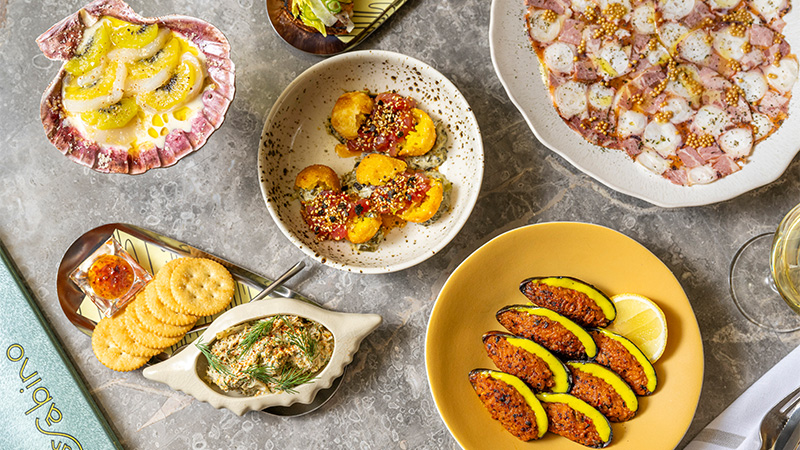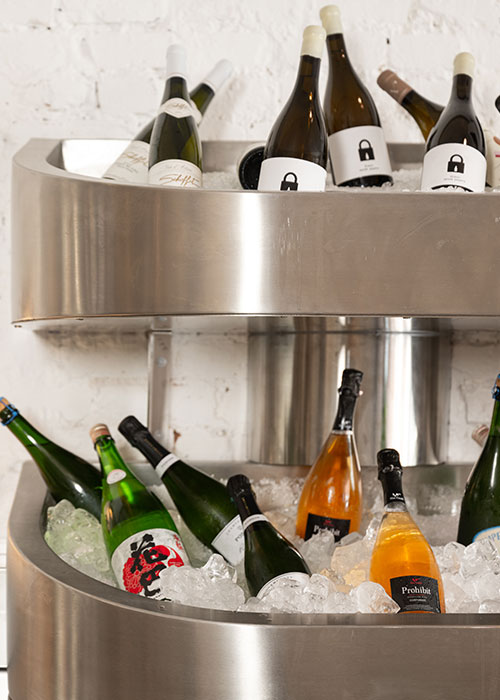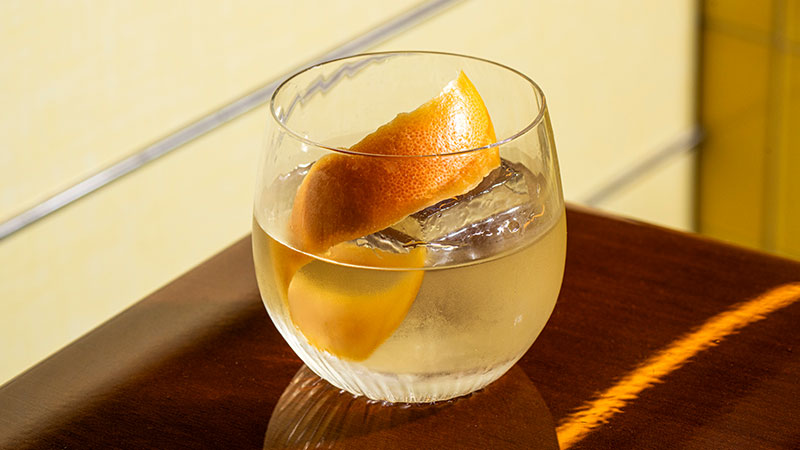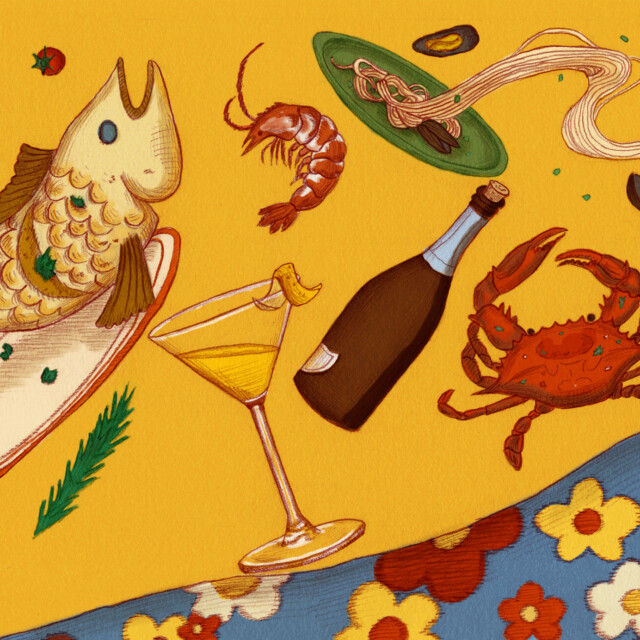This year, a new wave of hype-dining washed ashore in New York City. Seafood, in all of its stunning, salty forms, took center stage at the city’s buzziest restaurants. Sure, smash burgers are having a moment and hot dogs keep showing up on menus (sometimes in unexpected forms), but ultimately it’s the seafood-centric spots that have come to dominate the dining scene in 2024. This trend stretches beyond the influx of luxury bromakase options, wine bars slinging tinned fish, and dishes that boast often unnecessary spoonfuls of caviar. Instead, it’s a collection of innovative restaurants pushing the boundaries of what a singularly focused marine menu can offer.
Penny, a seafood counter perched above its predecessor, Claud, in the East Village, delivers particularly succulent examples of typical raw bar suspects alongside more complex dishes like Dover sole dotted with bone marrow. Theodora, a follow-up to Fort Greene’s beloved Mediterranean haunt Miss Ada, features dry-aged fish across its menu, from a selection of crudos to larger dishes cooked in an open-fire kitchen.
These spots, among other new openings like the coastal Italian San Sabino and Il Totano, Basque Eel Bar, and New Orleans-inspired Strange Delight, introduced fish dishes that are dry-aged, wood-fired, doused in chicken fat, or even covered in red sauce and cheese — a combination that would have many Italian Nonnas clutching their spatulas.
Traditional pairing advice dictates: “White wine with fish, red wine with meat.” And since guests gravitate toward reliable options Sancerre, Muscadet, and Chablis with marine fare, restaurants typically lean into them. But just as chefs stretch what an all-seafood menu can do, beverage professionals are pushing the limits of the accompanying drinks lists. In this wave of openings, diners can expect something new alongside their scallop crudo or swordfish belly — whether it’s a smoky mezcal cocktail, sparkling sake, or earthy skin-contact wine.

Breaking the Muscadet Mold
Theodora’s general manager, Maggie Dahill, discovered the grip of the “white wine with fish” convention during the restaurant’s opening week in February. “Within the first few weeks we just flew through the white wines and had to buy more immediately,” she says. “Coming from Miss Ada, which has a more diverse menu, I was used to seeing a pretty even split.”
Despite most drinkers’ inclinations, Dahill was determined to compile a list that pushed diners to try new combinations and interesting producers from across the globe. For those sticking with whites, she loves recommending Mediterranean wines, particularly the salty, smoky volcanic examples from Mt. Etna. But for the more open-minded, Dahill points to the skin-contact section of the menu. “Floral, salty, elegant skin-contact wines take the food to another level,” she says. “With the intensity of the smoke you get in the wood-fired dishes it’s nice to have something that wraps itself around it.”
Theodora’s use of dry-aged fish, as well as specialty wood-fired grills and charcoal ovens, adds an extra dimension of flavor to its dishes. Picking a wine that can level up to those savory, smoky, spicy notes — like one of Dahills favorites, a skin-contact Muscadelle from Oriol Artigas in Catalonia — helps match those complexities.
“Xarel-lo as a grape variety is one that everyone should be paying attention to.”
At Penny, wine director Ellis Srubas-Giammanco oversees a concise but well-rounded program with a robust selection of classic whites from Burgundy, Jura, and the Loire, as well as more obscure wines like still Palomino from Jerez and older Carignan Blanc from Languedoc-Roussillon. The by-the-glass offerings nudge drinkers toward the more left-field options, like Insolia from Sicily or white blends from Portugal. The list rotates, but a consistent favorite is the Bodega Clandestina ‘‘Sense Papers” Xarel-lo, from Penedès.

“Xarel-lo as a grape variety is one that everyone should be paying attention to,” Srubas-Giammanco says. “The value is incredible, and it’s something that can really appeal to Chablis drinkers. A perfect, briny, mineral white.”
In a year when two of the most talked about dishes in NYC are San Sabino’s hearty Shrimp Parm and the rich Lobster au Poivre at Demo, it’s safe to say that reds can find a home alongside seafood, too, especially considering the growing popularity of chilled reds. At Penny, Srubas-Giammanco looks to wines like the Nanclares y Prieto “A Senda Vermella” Mencia-based blend from Rías Baixas, Spain. The light-bodied wine, which comes in at about 9.5 percent ABV perfectly complements the restaurant’s grilled swordfish with Jimmy Nardello peppers. “It plays well with the red fruit, pepper, and earth notes,” he says.
Cocktails Have Entered the Chat
Pairing off-the-beaten-path wines with seafood is one thing, but what’s more surprising is a concerted emphasis on mixed drinks. With spirits demonstrating continued growth, more restaurants are embracing culinary-driven cocktails to complement their menus — seafood included.
Though wine is a major focus at red sauce joint Don Angie, down the street at the team’s new coastal Italian restaurant San Sabino, guests pair their crab-filled pastas and spicy tuna arancini with brightly colored cocktails.
“When we designed the beverage menu at San Sabino, we thought about our favorite seaside locations to dine, and our minds immediately went toward cocktails we’d want to drink on a beach,” says chef Angie Rito. “We also wanted the cocktails to align with the food menu in terms of its ethos — our style of cuisine is about risk-taking and a bit of ‘rule breaking,’ relying heavily on personal stories, with a strong thread of Italian and Italian-American ingredients mashed up with other unique and unexpected flavors.”
One example is the Sabinooch, the restaurant’s take on a white Negroni made with mezcal, a twist of grapefruit, and a house-made “Moscato Chinato.” The complex ingredient is a white riff on the traditional Italian fortified wine Barolo Chinato, made using Moscato. The drink is light and fresh, but also herbaceous, bitter, and smoky, making it a versatile pairing across the menu.

Theodora also set out to design a comprehensive cocktail program to complement its marine-centric menu. The drinks are split between easy-drinking, aperitivo-style cocktails that could accompany one of the restaurant’s fresh crudos, and technique-driven, complex creations that match the food’s more savory components. The latter include ingredients like caperberries, bay leaf, feta, anchovy, and even lamb fat, and frequently feature mezcal, as the spirit harmonizes with Theadora’s smoky, wood-fired preparations.
Theodora’s Mayahuel, for example, riffs on a mezcal Martini with an infusion of black pepper and bay leaves and a touch of honey. “It ends up being something that settles into the mid-palate of a lot of dishes,” Dahill says. “The food brings a lot of acidity, freshness, and brightness on the front and smoky finish on the back, and this fits right in the middle.”
A Spotlight for Sake and Sherry
At NYC’s hot new seafood spots, odds are that wine, beer, and cocktails aren’t the only sections on the menu — they’re making room for lesser-known beverages like sake, sherry, and vermouth.
When Srubas-Giammanco joined the opening team at Penny, he knew he wanted to feature both sherry and sake on the by-the-glass list. Though often underappreciated in the U.S., these categories are particularly well suited to fish and shellfish pairings. Plus, logistically, they have great shelf life, making them easier to take a risk on by the glass.
“Vermouth is usually tucked into a cocktail, and here we’re saying this is about the vermouth — it’s not the accessory.”
Srubas-Giammanco recalls a standout red rice-based Mukai Shuzo he poured during Penny’s opening week that guests were pleasantly surprised by. And though sherry seems to be a more difficult sell, Srubas-Giammanco likes to steer interested drinkers toward that section for certain pairings. “Right now we have a beautiful amontillado sherry, which is amazing with the lobster, basted in brown butter,” he says. “It’s salt meets umami meets unctuous lobster.”
Similarly, Eel Bar on the Lower East Side includes vermouth in two of its menu sections — with pours of blanco and rojo vermouth sitting alongside sherry under “Fortified Wines,” and a separate collection called “Prepared Vermouths” that features cocktails. This category includes drinks like the Marianito, made with Axta red vermouth, agricole rum, curaçao, Angostura, and an olive. Though Eel Bar could easily list these under the “cocktail” sections, featuring them separately draws attention to vermouth so guests can become more familiar with the category.
“Vermouth is usually tucked into a cocktail, and here we’re saying this is about the vermouth — it’s not the accessory,” Taylor Ward, Eel Bar’s director of operations, says.
Though not every drinker will be caught with a glass of sherry or vermouth while slurping shellfish at a bar, these establishments might convince curious guests to try new things. The same can be said about seafood itself, which wasn’t always as widely adored.
“People seem to be more open to exploring new flavors and ingredients now more than ever,” Rito says. “Although in the past seafood was a more polarizing category for people, that no longer seems to be the case.”
